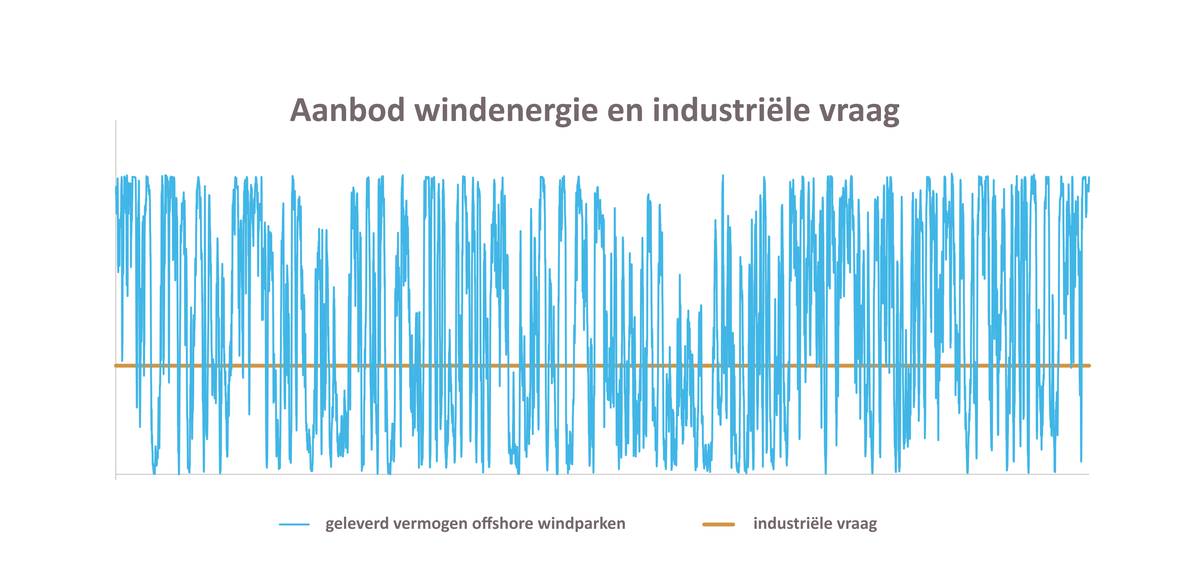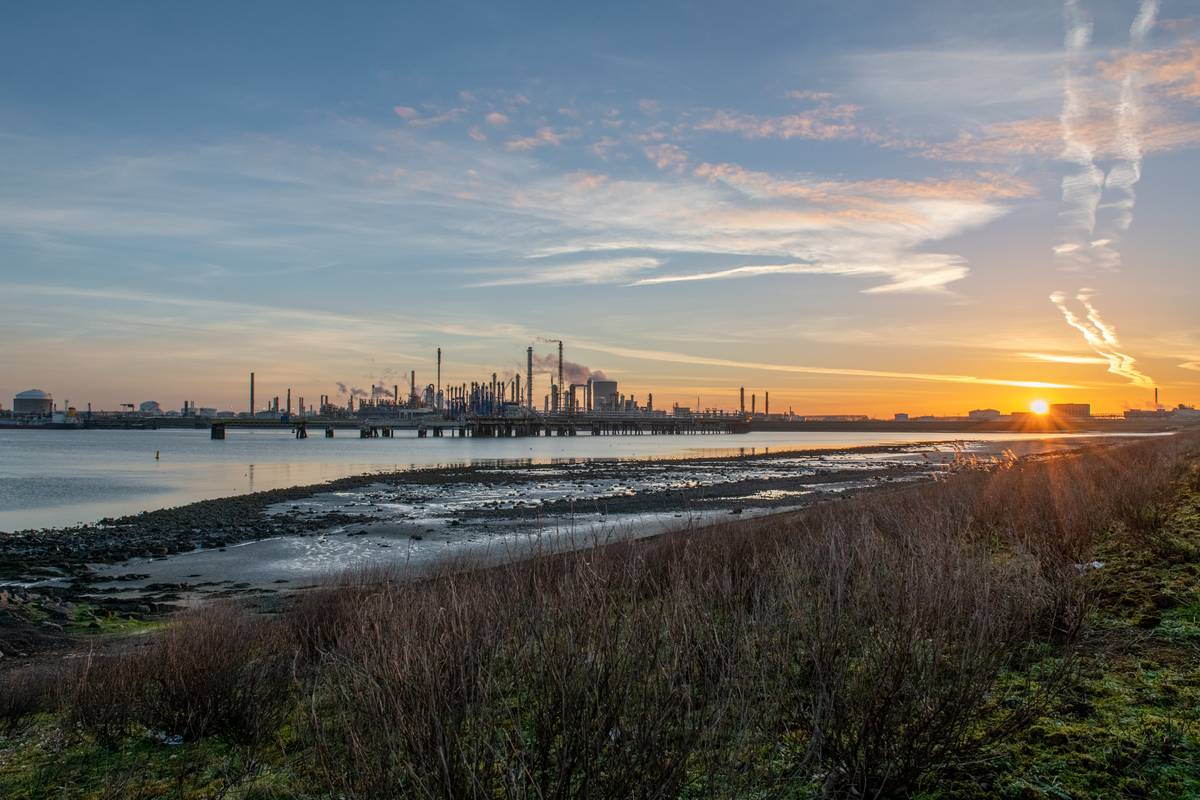Most processes in the industry continue day and night. Therefore, the demand for energy in the industry is almost constant. However, wind energy has peaks and troughs. There could be a few hours of less wind suddenly, and a lull could also last several days. These fluctuations become important as the industry electrifies more processes and thus becomes dependent on offshore wind energy. The report Flattening the Curve investigates techniques to align supply and demand.
The study assumes that various techniques will guarantee the supply of electricity alongside each other. Besides hydrogen, for instance, also thermal storage and limiting production in the industry.
The researchers use three scenarios for the development of the industry. There is a scenario with low electricity consumption, a scenario with high consumption, and a scenario with maximum electrification of industrial processes. Computer models calculate for each scenario how to best bridge the gap between supply and demand and what it costs.

Hydrogen
In all scenarios, hydrogen is an indispensable solution. This is a solid conclusion, as the scenarios vary greatly. Hydrogen is ideal to anticipate on windy times when there is a surplus of sustainable electricity, or it is imported. The production can be upped and used for times with less wind. During times of scarcity, a power plant starts up, using hydrogen as fuel. The required backup capacity varies per scenario. But hydrogen is always necessary to balance demand and supply. Thus, it's a no-regret option that can be powerfully further developed.
Hydrogen backup plants are expensive. Several other techniques are cheaper and more efficient. For example, storing heat and switching to hydrogen for heating. These techniques are used as much as possible in the study. But they can only bridge part of the gap between supply and demand. Hydrogen remains necessary.
Industry Shutdown
It's often thought that the industry can easily scale back when the wind drops. However, this proves difficult, as revealed by interviews conducted for the study. Many processes are hard to interrupt. The possibilities vary per company. On average, a reduction of twenty percent is achievable. Scaling back is also slow. It often takes several hours. The report calculates the costs of this. In the calculations, production limitation is always the last option when cheaper possibilities of backup plants and thermal storage are exhausted. A reduction above twenty percent is technically difficult without damaging the installations or endangering safety. It then takes days or even weeks before the installations can operate again.

Who Pays?
Building backup plants is a bottleneck, according to the study. These plants are only needed when wind turbines yield too little. This makes investing in them unattractive. Moreover, it's not precisely clear how much capacity is needed. The study suggests that the industry will contribute to supply security. Companies then pay a higher price for their electricity, but in return, get guaranteed capacity. Companies can best determine for themselves which certainty they need and what insurance premium they are willing to pay.
The report recommends further investigation into the financing of backup plants. Within TKI Offshore Energy, this includes thinking about the tendering of wind farms. The continuity of supply can play a role in the bids. It's not just about installed capacity, but also about the capacity that wind farms can deliver. The bidder thus solves part of the imbalance caused by the wind. This requires less flexibility in the industry and less deployment of backup plants. The power cables are also better utilized. This is technology-neutral. The bidder can also choose solutions other than hydrogen. This, for instance, encourages the improvement of wind turbines.
Better Turbines
According to the report, innovation in wind turbines could become an important solution in the future to balance supply and demand. New rotor designs promise to extract more from the wind when it blows softly. These kinds of techniques are still experimental. Therefore, improved turbines are not included in the calculations. But the report does recommend focusing innovation on new turbine designs.
Offshore Solar
Another solution is installing solar panels at a wind farm. When there's no wind, sometimes the sun shines. But not always: thus, solar panels provide only a small addition. The combination of sun and wind saves on infrastructure, as no additional power cables to the shore are needed. However, it's unclear according to the report whether this outweighs the costs of solar panels that float on water. The technology has not yet been applied on the required scale. Therefore, the costs contain significant uncertainties.
Thermal Storage
Thermal storage can make an important contribution to bridging the gap between supply and demand. Electric boilers and resistance heating are cheap and simple techniques to heat water or other materials when it's windy. This makes heat available during a lull in the wind. Boilers can bridge fluctuations of up to a day. Other heat storage techniques are still too expensive. Heat pumps operate at a lower temperature than boilers and therefore need larger buffers. This combination is currently too costly.

Onshore Hydrogen Production
According to the study, hydrogen production on land is about as expensive as production at sea. This is a surprising conclusion, as it's often thought that production at sea is cheaper. However, the prices of industrial estates are still attractive. Less than five percent of the investments in a hydrogen factory are needed for land purchase.
For hydrogen production at sea, a power cable and a gas pipeline to the shore are needed. The power cable feeds the industry most efficiently when it's windy enough. With only hydrogen production, the losses are too great.
The study does not separately consider wind farms that are very far from the coast. The calculations assume a fixed distance of 250 km. But wind farms can be built further from the coast. One hundred percent hydrogen production, without a power cable to the shore, might then be attractive. Especially if hydrogen is not an energy carrier, but a raw material for chemistry and iron production.
Outside the Industry
The calculations only consider the electricity demand in the industry. The rest of the energy system is not considered, as this would make the computer models too complex. Therefore, solutions elsewhere in society remain invisible. According to the study, using batteries to bridge windless periods is not attractive. But this could change if batteries outside the industry are used – in electric cars, households, or at solar parks on land.
Stimulating Demand
The report opens with graphs showing how the electrification of the industry coincides with the construction of wind farms. This is perhaps the biggest uncertainty in the calculations. Both the demand and supply of sustainable electricity must be stimulated to meet climate goals. Long-term surplus or structural deficit cannot be resolved with buffering.
